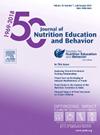青少年食物环境与饮食摄入之间的关系。
IF 2.3
3区 医学
Q2 EDUCATION, SCIENTIFIC DISCIPLINES
引用次数: 0
摘要
目的:探讨家庭和邻里食物环境的各个方面作为青少年饮食的预测因素。设计:横断面研究。环境:内布拉斯加州的研究实验室。参与者:数据来自一个更大的纵向研究的青少年阶段。参与者包括204名青少年(平均年龄15.3岁)和照顾者。主要结果测量:自变量包括通过有效问卷评估的家庭食品环境和通过地理信息系统方法和亲自审计评估的社区食品环境。通过家庭生活、活动、阳光、健康和饮食问卷和24小时回忆测量来评估饮食结果变量。分析:层次多元回归分析。P < 0.05为显著预测因子。结果:家庭水果和蔬菜供应预测更高的自动自我管理24小时健康饮食指数得分(P = 0.03),更高的家庭生活,活动,阳光,健康和饮食测量的水果和蔬菜摄入量(P = 0.003),更高的营养密集食物消费(P = 0.01),更少的快餐摄入量(P = 0.02)。家庭脂肪和甜味可得性正预测能量密集、营养不良的食物(P = 0.01)、不健康的食物(P < 0.001)和含糖食物的摄入(P < 0.001)。便利店计数正预测营养密集食品消费(P = 0.04)。快餐计数正预测含糖饮料消费(P = 0.01)。结论与启示:研究结果表明,与邻里食物环境相比,家庭食物环境对青少年饮食的影响更大。未来的研究需要确定家庭饮食环境是否可以作为一个可修改的干预目标,以解决青少年肥胖率上升的问题。本文章由计算机程序翻译,如有差异,请以英文原文为准。
Associations Between Adolescent Food Environments and Dietary Intake
Objective
To examine aspects of the home and neighborhood food environment as predictors of adolescent diet.
Design
Cross-sectional study.
Setting
Research laboratory in Nebraska.
Participants
Data drawn from the adolescent phase of a larger longitudinal study. Participants included 204 adolescents (mean age of 15.3 years) and caregivers.
Main Outcome Measures
Independent variables included the home food environment assessed via a validated questionnaire and the neighborhood food environment assessed via geographic information system methods and in-person audits. Dietary outcome variables were assessed using the Family Life, Activity, Sun, Health, and Eating questionnaire and a 24-hour recall measure.
Analysis
Hierarchical multiple regression analysis. P < 0.05 indicated a significant predictor.
Results
Home fruit and vegetable availability predicted greater Automated Self-Administered 24-hour Healthy Eating Index score (P = 0.03), greater Family Life, Activity, Sun, Health, and Eating-measured fruit and vegetable intake (P = 0.003), greater nutrient-dense food consumption (P = 0.01), and less fast-food intake (P = 0.02). Home fat and sweet availability positively predicted energy-dense, nutrient-poor food (P = 0.01), less healthful food (P < 0.001), and sugary food intake (P < 0.001). Convenience store counts positively predicted nutrient-dense food consumption (P = 0.04). Fast-food counts positively predicted sugary beverage consumption (P = 0.01).
Conclusions and Implications
Findings suggest that, compared with the neighborhood food environment, the home food environment displays a greater number of associations with adolescent diet. Future research is needed to determine if the home food environment may act as a modifiable intervention target to address the elevated rates of adolescent obesity.
求助全文
通过发布文献求助,成功后即可免费获取论文全文。
去求助
来源期刊
CiteScore
4.20
自引率
11.50%
发文量
379
审稿时长
44 days
期刊介绍:
The Journal of Nutrition Education and Behavior (JNEB), the official journal of the Society for Nutrition Education and Behavior, is a refereed, scientific periodical that serves as a global resource for all professionals with an interest in nutrition education; nutrition and physical activity behavior theories and intervention outcomes; complementary and alternative medicine related to nutrition behaviors; food environment; food, nutrition, and physical activity communication strategies including technology; nutrition-related economics; food safety education; and scholarship of learning related to these areas.
The purpose of JNEB is to document and disseminate original research and emerging issues and practices relevant to these areas worldwide. The Journal of Nutrition Education and Behavior welcomes evidence-based manuscripts that provide new insights and useful findings related to nutrition education research, practice and policy. The content areas of JNEB reflect the diverse interests in nutrition and physical activity related to public health, nutritional sciences, education, behavioral economics, family and consumer sciences, and eHealth, including the interests of community-based nutrition-practitioners. As the Society''s official journal, JNEB also includes policy statements, issue perspectives, position papers, and member communications.

 求助内容:
求助内容: 应助结果提醒方式:
应助结果提醒方式:


